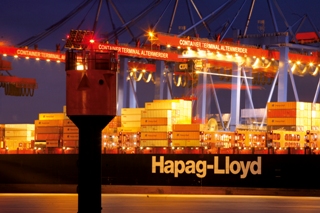 German container shipping line Hapag-Lloyd fell deeper into loss in the first half of the year compared with the same period last year, as an increase in transport volume and intensified cost-cutting efforts failed to counterbalance falling freight rates and a weakened dollar.
German container shipping line Hapag-Lloyd fell deeper into loss in the first half of the year compared with the same period last year, as an increase in transport volume and intensified cost-cutting efforts failed to counterbalance falling freight rates and a weakened dollar.
The company reported a net loss of EUR173.3 million (US$231.57 million) in the first six months of the year (including one-off costs relating to the CSAV transaction) versus a EUR72.7-million loss year-over-year.
“After a weak first quarter, which is usual in the liner shipping sector, the upturn in the second quarter failed to live up to expectations,” it said.
Cargo volume expanded by 5.8 percent to around 2.9 million TEUs in the first half of 2014, but average freight rate slid by US$98 per TEU year-over-year to $1,424 per TEU “as a result of persistently tough competition across the market,” it further said.
Revenue in the first six months of 2014 amounted to EUR3.21 billion from EUR3.35 billion in the prior-year period “due to the poor freight rate development and the much weaker US dollar.”
The poor results came despite a reduction in transport expenses by EUR79 million year-over-year to just under EUR2.9 billion in the first half-year.
“Even with reduced transport expenses, it was impossible to make up for the massive impact that falling freight rates had on earnings,” said the Hamburg-based carrier.
In the first half of 2014, EBITDA (earnings before interest, taxes, depreciation, and amortization) reached EUR67.2 million against the prior-year period’s EUR171.8 million, while operating loss totaled EUR73.7 million against the preceding period’s loss of EUR13.5 million.
‘The fact that we ended up with this unsatisfactory result despite clear efforts to cut costs is down to the disappointing development of freight rates across all trades,” said group CEO Rolf Habben Jansen. “We expect, however, to see a better result in the second half of the year even though the environment remains tough.”
Jansen said the company is banking on continued cost-cutting and the merger with Chilean carrier CSAV to boost its financial performance. The CSAV merger will “enable us to realize synergies worth at least USD300 million per annum in the future,” he added.
The transaction is still subject to the approval of about a dozen competition authorities around the world, but was already rubber-stamped by relevant U.S. authorities in July. The transaction is expected to be concluded in the fourth quarter, once all the key competition authorities have granted their approval, said the company.
“In view of the negative impact on earnings in the first half of 2014 resulting from the persistent pressure on the freight rate and in consideration of an unchanged difficult sector environment, Hapag-Lloyd aims for a positive operating result for 2014 as a whole, albeit clearly lower than in 2013,” said the company.
GRI set for September
Meanwhile, it announced a general rate increase in the eastbound trans-Pacific trade effective next month.
The GRI will include all dry, reefer, flat-rack and open-top containers from East Asia to all U.S. and Canada destinations and take effect September 1.
The rate hike is US$480 per 20-foot standard container, $600 per 40-foot standard container, $650 per 40-foot high-cube unit, and $760 per 45-foot box.
East Asia is defined as Japan, Korea, Taiwan, Hong Kong, China, Vietnam, Laos, Cambodia, Thailand, Myanmar, Malaysia, Singapore, Brunei, Indonesia, Philippines, and the Russian Pacific Coast Provinces.




